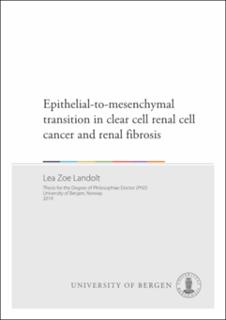Epithelial-to-mesenchymal transition in clear cell renal cell cancer and renal fibrosis
Doctoral thesis
Permanent lenke
https://hdl.handle.net/1956/21394Utgivelsesdato
2019-01-16Metadata
Vis full innførselSamlinger
Sammendrag
Background: Clear cell renal cell cancer (ccRCC) is a common cancer in humans and still has a high mortality. Chronic kidney disease (CKD) is a worldwide public health issue due to its increasing incidence and high morbidity and mortality related to accelerated cardiovascular diseases. Renal fibrosis is the histopathological correlate of CKD. Epithelial-to-mesenchymal transition (EMT) is a biological process where cells acquire mesenchymal characteristics such as loss of cell-cell adhesion, enhanced migratory capacity and production of extracellular matrix. In the case of cancer, EMT is involved in tumor progression, aggressiveness and therapy resistance. In the case of fibrosis, partial EMT drives the activation of myofibroblasts and the accumulation of extracellular matrix. AXL receptor tyrosine kinase is an EMT induced effector and is known to play a role in cancer aggressiveness, therapy resistance and fibrosis development. Renal biopsy archives such as the Kidney Biopsy Registry of the Norwegian Renal Registry are valuable sources for renal tissue analyses. Modern molecular analysis of archival renal biopsies could help to investigate pathomechanisms, and define potential biomarkers and new drug targets of renal diseases. The aims of this work were to: 1) evaluate the best method to extract RNA from archival formalin-fixed paraffin-embedded (FFPE) renal biopsies to enable RNA sequencing; 2) to study EMT markers in ccRCC tissues of our patient cohort; and 3) to detect AXL in unilateral ureteral obstruction (UUO), a murine renal fibrosis model, and to quantify fibrosis after inhibition of AXL by the selective small molecule BGB324 in UUO. Methods: In paper I, we tested seven commercially available RNA extraction kits on rat and human FFPE renal biopsy sections and on laser-capture microdissected (LCM) glomerular cross-sections to enable RNA sequencing from archival FFPE renal tissues. In paper II, FFPE sample pairs of ccRCC and adjacent normal tissues from our ccRCC cohort were used to characterize EMT markers by immunohistochemistry (IHC) and to analyze RNA, miRNA sequencing and proteomic data with respect to EMT and fibrosis. In paper III, we analyzed AXL in kidneys subjected to UUO in C57Bl/6 mice and assessed fibrosis extent by Sirius Red (SR) staining and hydroxyproline content after treatment with BGB324 or its vehicle. These analyses were supplemented by RNA sequencing including pathway analyses and by ELISA. We later analyzed the presence of AXL in diabetic and nephrosclerotic FFPE human biopsy tissues by IHC and RNA sequencing. Results: In paper I, four commercially available RNA extraction kits were suitable to isolate sufficient RNA from one human FFPE renal biopsy section and from around 100 LCM glomerular cross-sections with the Illumina TruSeq RNA Access Library Preparation kit. In paper II we demonstrated that EMT and fibrosis are prominent features in ccRCC samples of our cohort, that EMT related genes such as AXL, vimentin and matrix metalloproteinase 14 (MMP14) are associated to tumor stage in our cohort, and that expression levels of AXL, MMP14 and Klotho correlate with survival in publicly available datasets of ccRCC patient cohorts. In paper III, we found that AXL was distinctly more expressed in ligated compared to non-ligated kidneys in UUO. BGB324 treatment attenuated fibrosis development in ligated kidneys compared to ligated vehicle treated kidneys 15 days after obstruction. Tissue analyses and RNA sequencing data were compatible with reduced (partial) EMT and reduced inflammation in ligated BGB324 treated compared to the vehicle treated control. Conclusion: Paper I: RNA sequencing from human FFPE renal biopsies is feasible from one single biopsy section and from around 100 LCM glomerular cross-sections using the Illumina TruSeq RNA Access Library Preparation kit. Archival renal biopsy tissues are thus suitable for transcriptome sequencing. Paper II: EMT and fibrosis are substantial characteristics of ccRCC in our patient cohort and are associated with prognosis based on publicly available ccRCC datasets. Genes related to EMT including AXL may therefore be further evaluated as potential treatment targets. Paper III: AXL is involved in fibrosis development in UUO and inhibition of AXL by BGB324 reduces fibrosis development of UUO. AXL is present also in fibrotic human renal biopsy tissues and AXL therefore represents a potential therapeutic target for renal fibrosis.
Består av
Paper I: Landolt L, Marti HP, Beisland C, Flatberg A, Eikrem Ø. RNA extraction for RNA sequencing of archival renal tissues, Scandinavian Journal of Clinical and Laboratory Investigations, 2016; 13:1-9. The article is not available in BORA due to publisher restrictions. The published version is available at: https://doi.org/10.1080/00365513.2016.1177660Paper II: Landolt L, Eikrem Ø, Strauss P, Scherer A, Lovett DH, Beisland C, Finne K, Osman T, Ibrahim MM, Gausdal G, Ahmed L, Lorens JB, Thiery JP, Tan TZ, Sekulovic M, Marti HP. Clear Cell Renal Cell Carcinoma is linked to Epithelial-to-Mesenchymal Transition and to Fibrosis, Physiological reports, 2017, 5 (11): e13305. Corrigendum: Physiological reports, 2018, 6 (8): e13671. The article is available at: http://hdl.handle.net/1956/18332
Paper III: Landolt L, Furiol J, Babickova J, Ahmed L, Eikrem Ø, Skogstrand T, Scherer A, Leh S, Lorens JB, Gausdal G, Suliman S, Marti HP, Osman T. Inhibition of Axl receptor tyrosine kinase reduces fibrosis development in experimental unilateral ureteral obstruction. Published as: AXL targeting reduces fibrosis development in experimental unilateral ureteral obstruction. Physiological Reports. 2019;7(10):e14091. The article is available at: http://hdl.handle.net/1956/21392
